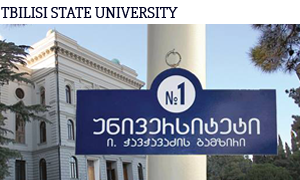
FACULTY OF PSYCHOLOGY AND EDUCATIONAL SCIENCES
INDICATORS OF POST-TRAUMATIC GROWTH (PTG) AND PSYCHOLOGICAL WELL-BEING IN LIFE STORIES
Scientists from Ivane Javakhishvili Tbilisi State University (TSU)carried out a study “Indicators of Post-traumatic Growth and Psychological Well-being in Life Stories” in December 2013 under the guidance of TSU Assistant Professor Lili Khechuashvili from the Institute of Individual and Clinical Psychology and the Faculty of Psychology and Educational Sciences. Kate McLean, Associate Professor of Psychology at Western Washington University, Director of the Memory and Identity Lab, is a partner with the Georgian project.
Graduates of the TSU Faculty of Psychology and Educational Sciences (who were BA and MA students when the study began), as well as current BA students are also involved in the study. A group of young psychology researchers is carrying out qualitative data coding; the team includes Maia Mazanishvili and Nino Gugushvili, MPsy; Ana Shavgulidze and Mariam Lamazoshvili, BA students; and Lela Lezhava, fourth-year BA student. The study is being implemented within the Central Asia and Caucasus Research and Training Initiative Senior Fellowship (CARTI) under the International Higher Education Support Program of the Open Society Foundation.
The research uses mixed methods to identify indicators of post-traumatic growth and psychological well-being in life stories of the research participants. The research was planned and implemented in several stages, each of which had its own goal and expected results.


At the first stage two instruments using self-report questionnaires were adapted to the Georgian context by agreement and permission of their authors: a) psychological well-being scales and b) a post-traumatic growth questionnaire. At this stage, a total of 1189 participants have taken part in the pilot studies and psychometric properties studies. These two instruments have already been finalized and other psychologist-researchers can use the existing Georgian questionnaires.
The second stage made up the main part of the research and included 90 persons. Forty-five were IDPs who had been forced to flee their homes after the 2008 August war and currently live in homes provided by the state, and 45 non-IDP citizens who participated in most of the study. Each respondent answered a questionnaire, and had a life story interview. New demographic data appeared that proved an important distinctive factor when interpreting some data.


Novelties and findings of the research include the fact that two research tools were adapted and adjusted: a post-traumatic growth questionnaire and a psychological well-being scale. These tools are new for Georgia, yet people are willing to speak about their own lives and talk openly about the most difficult, intimate and painful/happy moments.
The study has showed that various generations (those who lived in the Soviet era and those who lived after the 1990s) differ significantly for all major parameters when describing themselves and how they talk about their own lives. A clear tendency became apparent for persons of the older generation found that their ideal, untroubled, idyllic situation was replaced by chaos and ambiguity, closely replicating the historical reality they had to live. The next generation, growing up in the chaotic decade of the 1990s, are more oriented towards achievements and positivism. The generalization of life stories reveals a collective narrative with a certain cultural script, or a so-called master narrative that is still in the process of being formed by the present reality. It is developing in two directions—a comparatively traditional Georgian one (motherland, mother tongue and faith) and a modernist one (globalization, cosmopolitan vision); each of them is typical to a certain age group. Narrative identity is directly linked, and emerges from a national identity found in the participants’ stories multiple times.
 Interim conclusions of the research reveal that IDPs are less likely to see new opportunities around them than other participants do, however the two groups do not differ in their psychological well-being indicators. It indicates that IDP status has no effect on subjective well-being. Very different factors work here; a sense of psychological well-being is closely related to socio-economic status and income. For both groups – IDPs and others – the lower the income, the lower their subjective well-being. Therefore, socio-economic factors are good predictors of psychological well-being. This picture changes for those who categorize themselves as “poor”, who feel better than those with average incomes.
Interim conclusions of the research reveal that IDPs are less likely to see new opportunities around them than other participants do, however the two groups do not differ in their psychological well-being indicators. It indicates that IDP status has no effect on subjective well-being. Very different factors work here; a sense of psychological well-being is closely related to socio-economic status and income. For both groups – IDPs and others – the lower the income, the lower their subjective well-being. Therefore, socio-economic factors are good predictors of psychological well-being. This picture changes for those who categorize themselves as “poor”, who feel better than those with average incomes.
Pic.:Compact settlements for IDPs
The researchers believe that “well-being” as a construct may be perceived differently by the two groups.
For post-traumatic growth (irrespective of which group), this indicator is higher for women than men. In particular, after a traumatic experience women improve their relations with others and beginto appreciate life (they become more religious and pay more attention to their spiritual lives). This indicator reflects the results of studies conducted in various other cultures as well. Generally, women have slightly more, firmly reliable growth indicators.
In terms of subjective post-traumatic growth indicators, those who divorced their partners/spouses manage better to see new opportunities than those who suffered the death of people close to them. This result (the fact that the overall picture of post-traumatic growth is different according to the type of traumatic event) concurs with opinions and results carried out in other cultures (Japan, Germany, Turkey, Scandinavian countries, Italy and Spain). The overall picture of post-traumatic growth changes according to what kind of trauma/stress experience a person has gone through.
A large amount of data analysis was carried out on life stories told by participants. Because of the diversity and great volume of materials, at this stage only those variables and components were analyzed that related directly to post-traumatic growth. In particular, a detailed redemption sequence coding scheme was developed. Two research assistants independently coded 540 memories from 90 interviews (6 memories from each story). A 90% agreement was reached, which is quite a high indicator for similar studies.
The “redemption sequence” is encountered only in one-third of coded memories, in cases where a demonstrably bad or emotionally negative event or circumstance led to a demonstrably good or emotionally positive outcome. For example, after ruining relations with friends, people become more attentive towards other people. People evoke experiences in the redemption sequence that they consider a decisive moment in their lives. The same structure is frequently found in memories of negative experiences that closely reflect the studies conducted in other cultures. The present study has also demonstrated that people tell about bad, painful experiences more comprehensively, intensively and often repeatedly and followed by more reflection. Seeking an opinion is prevalent and thus a personal growth element more common. This is less observed in the case of positive developments and probably happens because people do not question good things. Only bad stories need an opinion. Very frequently, people who put their lives in redemption sequence are basically learning, growing personally and improving themselves as a result of negative experience. 
Whether a person is an IDP or not, in most cases a redemption sequence is present for decisive events and negative experiences, which indicates possible universal properties. We learn from negative experience. However, if we move to a deeper level of analysis and compare IDPs with other participants, we see that the two groups do differ from each other in how they structure the narratives of their lives. Non-IDPs use a redemption sequence more frequently than IDPs. Agency (activity and achievement orientation) improves as a result of bad experience, and interrelations with other people are more frequent. However, if IDPs use a redemption sequence, they most likely focus on such issues as adaptation, which isn’t found in the other group, and improvement, which basically implies improved relations and social/living conditions.
Thus, we can state that IDP status and memory types reliably predict how frequently the redemption sequence will be presented in a person’s life story. For example, we can say that if a person lives in Tserovani (IDPs reside in this village) and tells us about the best moment of their life, it is less likely that they will tell a story in redemption sequence than when speaking about a decisive moment; but if our interlocutor is from Tbilisi or, for instance, lives in Baghdadi and tells about a decisive moment, it is very probably that their story will contain more redemption sequences than both stories told by the first interlocutor.
The researcher linked this with other aspects of post-traumatic growth, measured by the questionnaire and drawn from life stories of the participants. A moderate positive connection was found between redemption sequences taken from memories on one hand, and two aspects of post-traumatic growth on the other. This included seeing new opportunities and personal growth, which enable us to predict a post-traumatic growth level if we know if the frequency a person uses this sequence in narratives is the same as that in research by other scientists – for example by the authors of the post-traumatic growth model. Similarly, a moderate but reliable connection was found between redemption sequence and psychological well-being, and this also matches existing studies that show that redemption sequence in narratives is reliably linked with high well-being and happiness indicators.
Concerning the practical use of the research and other issues, several observations include:
The integration of traumatic experience into a life narrative and coherent narrative is a good predictor of psychological well-being and mental health in general. This is confirmed by a series of studies conducted in the United States. The present studyalso confirmed this result. The more sequentially participants tell their life stories and include traumatic experiences(for example among IDPs it is the loss of housing and resettlement)and the more they have reflected on them, the higher their post-traumatic growth indicator is and the more “redemptively” (redemption meaning bad events are followed by good events) they construct their life stories. Subjective well-being is also comparatively higher among them. This is of practical value for psychologists, consultants and those who work with similar issues. More specifically, a sequential and reflective narrative, mostly constructed in redemption sequence, is a sign and predictor of improved mental health that points to positive outcomes for therapy, consultancy.
The study also showed that IDPs, compared to other participants, face more difficulties in verbalization and sequential narratives. This can be explained by an education variable and cultural attributes when speaking about one’s own experiences and opinions is not encouraged. It seems at this stage, however, we can talk only about a tendency that less – educated participants face more difficulties in reflection and verbalization of their feelings than those with a higher education. Since the number of participants is not high in the study, we cannot resolutely assert this, however. This is the first mixed-method research conducted in Georgia on this issue, and it considers integration of self-report questionnaires and life stories. In addition, it is the first research using narrative approaches that is related to IDPs within the framework of narrative identity model. The qualitative part of the research is the first endeavor to consider the formation of cultural script, i.e. a master narrative on the basis of analyzing interviews.
Another practical use is comparatively technical: 96 life story interviews were recorded, collected and transcribed. This material contains very much unprocessed information that can be used by other researchers (including students), and for educational purposes in relevant courses. For example, during a semester a researcher can use transcripts of interviews conducted during the research. Two new courses were created during the research that will be offered to students from the Faculty of Psychology and Educational Sciences, or as selective courses for other students. These courses are: “Life Story Interview and Narrative Analysis” and “Psychobiography”.
Based on the above research, a new research project was written which has already received a Fulbright Scholarship funding and the researcher will spent the next eight months at the Western Washington University. Together with Kate McLean, the Georgian researcher will work on the correlations of life stories and the master narrative of Georgian immigrants and Georgians living in Georgia.
Due to a lack of financing the research results were presented at only one international conference as: “Comparative study of psychological well-being and post-traumatic growth of IDP and non-IDP citizens of Georgia“. Conference title: International Psychological Applications Conference and Trends 2015 (In PACT 2015), Clinical psychology section, 2-5 April, 2015, Ljubljana, Slovenia.
Part of the results were received for oral presentation at the annual congress of the American Psychological Association titled: “Post-traumatic Growth and Redemption in Life Story Narratives of Georgian Sample: Comparative Study of IDPs and Non-IDP Citizens of Georgia“; conference: 17th Annual Convention of the Society for Personality and Social Psychology (SPSP), San Diego, CA, USA.
Presently, parts of the present study are being printed and will be included in the book Psychology Applications & Developments II as Chapter 4, “Post-traumaticGrowth and Psychological Well-being of Georgian Citizens (comparative study of internally displaced persons and other citizens).
An article “Investigation of Psychometric Properties of the Georgian Version of Post-traumatic Growth Inventory“ will be published in Journal of Loss and Trauma issued by the American Psychological Association.
Publications have appeared in local peer-reviewed journals.




